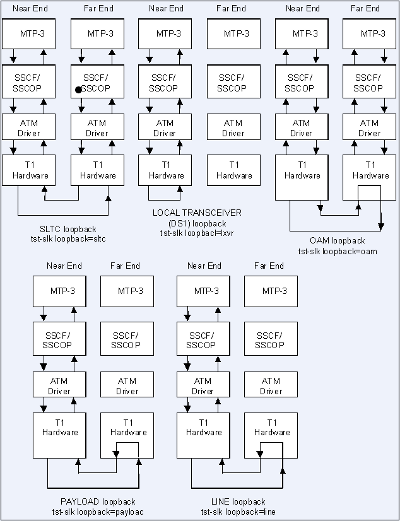A.11 Summary of Loopback Testing Commands and Functions
Table A-10 and Figure A-1 summarize the loopback testing commands and functions in the system.
The tst-slk command provides several methods for testing signaling links. The loopback parameter provides the ability to select lxvr (local transceiver), oam, line, payload, and sltc loopback tests. The command will be rejected if a loopback test is not compatible with the link type.
- For low-speed links, the lxvr and sltc tests are allowed.
- For high-speed links (ATM, E5-ATM-B), the lxvr, oam, line, payload, and sltc tests are allowed.
- For SS7IPGW and IPGWI DCMs, the
tst-slkcommand is not supported. - For LIME1 or LIMT1 cards, or for the E5-ENET-B cards running the IPSG application, only the loopback=sltc test is allowed.
- The E5-E1T1-B cards can function as either an E1 MIM card or a T1 MIM card, depending on how the card is provisioned. The loopback=sltc test is allowed.
The act-lbp command activates test on one or more loopback points for testing data signaling link elements in one CCS7 transmission path. The maximum number of loopback points is 32.
For a single loopback point test, the parameters can be entered on the command line. If the parameters are not entered at the command line, the LFS database is used. For multiple loopback point tests, the LFS database must be used.
The ent-lbp command is used to create the loopback points in the LFS database. The LBPs may be entered in any order.
See the command descriptions in this manual for details on entering parameters and using the commands.
Table A-10 Loopback Testing Commands and Functions
| Command/Function | Card Supported | Testing limits |
|---|---|---|
|
Link State-Down Equipment tested-All links on the T1 port Purpose-tests connectivity between 2 nodes at the T1 level with some isolation for the LIU and/or framer Description-Tests near-end card for line, lxvr, and network payload loopback and far-end card for line and payload loopback. Typical use-Tests connectivity |
|
1024 concurrent tests per system |
|
No impact on link behavior other than allowing multiple points |
|
32 points per card no limit on # of cards |
|
EAGLE initiated Level 1 DS0 LFS tests Link State-Down Equipment tested-Level 1 element(s) in a signaling path Purpose-Test the error rates of a signaling path Description-Sends loopback code to establish loopback, then performs BERT test for a specified period of timed Typical use-Validates signaling path has acceptable error rate |
|
1024 concurrent tests per system |
|
Remote Loopback FAR END initiated DS0 LFS Test Link State-Up or down Equipment tested-Near end hardware up to level 2 and far end hardware level 1 interface Purpose-Auto-Loopback a BERT test to the far end Description-When receiving a loopback code, deactivate the link and go into loopback Typical use-Remotely tests the far end with standard DS0 BERT tests |
|
no limit on # of cards |
|
Link State-Up Equipment tested-Near and far end up to Level 3 Purpose-Test the entire path to the far end at Level 3 Description-Sends an SLTM out and expects an SLTA back Typical use-Validates connectivity of a signaling path |
|
1024 concurrent link tests per system |
|
Link State-Down Equipment tested-Near and far end level 1 software and hardware including all hardware on the cards Purpose-Test the entire near and far end level 1 hardware by exchanging ATM cells Description-Sends OAM cells out to far end for 60 seconds if no errors, or 2 minutes if errors are received Typical use-Verifies ATM cells can be exchanged between 2 signaling points |
|
1024 concurrent link tests per system |
|
Link State-Down Equipment tested-Near end hardware up to level 2 and far end hardware level 1 interface Purpose-Hardware continuity check between near and far end Description-The following steps occur:
Note: If the DUT boots in the middle of sequence, activate or de-activate the link, and the remote device returns to the original programming.Typical use-Checks continuity from the near end level 2 hardware to the level 1 interface at the far end for a link in line timing |
|
1024 concurrent link tests per system |
|
Link State-Down Equipment tested-Near end hardware up to level 2 and far end hardware level 1 interface Purpose-Hardware continuity check between near and far end Description-The following steps occur:
Note: If the DUT boots in the middle of sequence, activate or de-activate the link, and the remote device returns to the original programming.Typical use-Checks continuity from the near end level 2 hardware to the level 1 interface at the far end for a link in master timing |
|
1024 concurrent link tests per system |
|
Link State-Down Equipment tested-Local card Purpose-Test the near end card only Description-Test the near end card up through level 2. Typical use-Validates the card on the Eagle as good |
|
1024 concurrent link tests per system |
|
Link State-Down Equipment tested-All links on the E1 port Purpose-Tests connectivity between 2 nodes at the E1 level with some isolation for the LIU and/or framer Description-Tests near-end card for line, lxvr, and payload loopback Typical use-Tests connectivity |
|
1024 concurrent tests per system |
|
Link State-Down Equipment tested-All links on the T1 port Purpose-Tests connectivity between 2 nodes at the T1 level with some isolation for the LIU and/or framer Description-Tests near-end card for line, lxvr, and payload loopback and far end card for line and payload loopback Typical use-Tests connectivity |
|
1024 concurrent tests per system |
Figure A-1 ATM Loopback Tests
